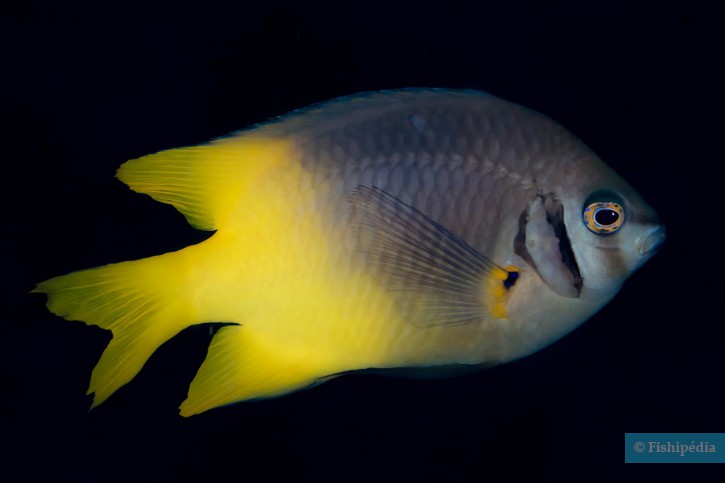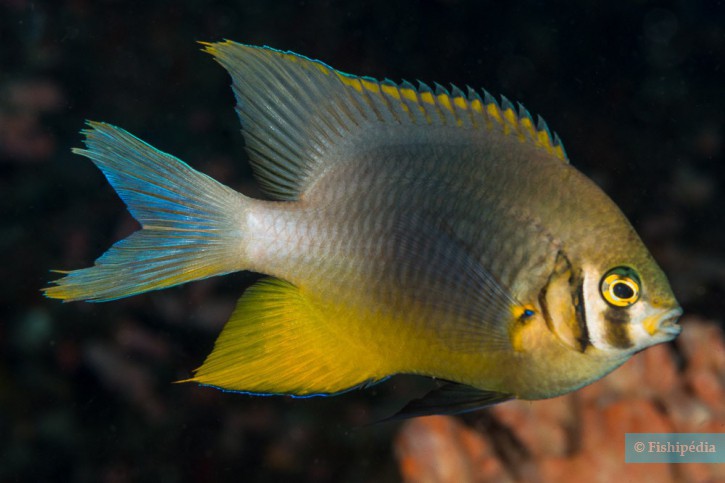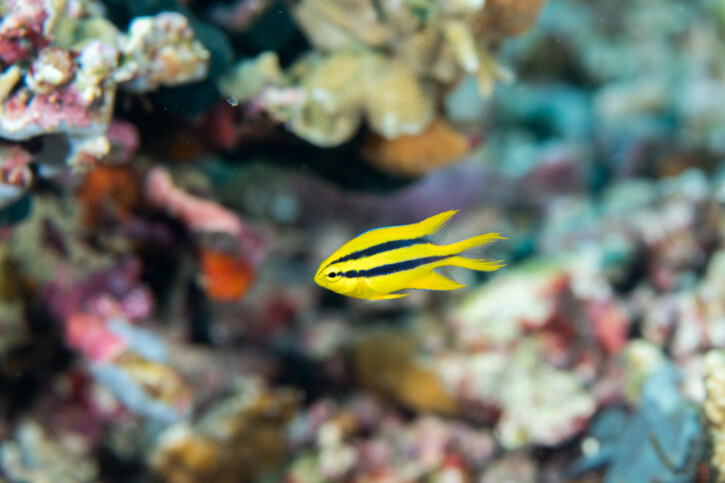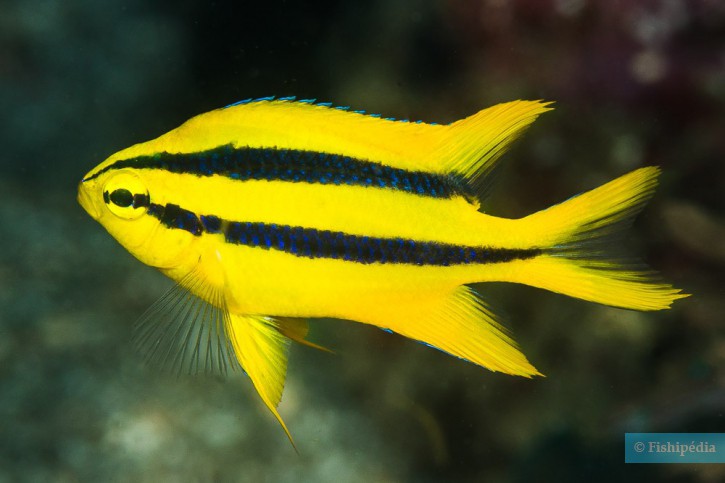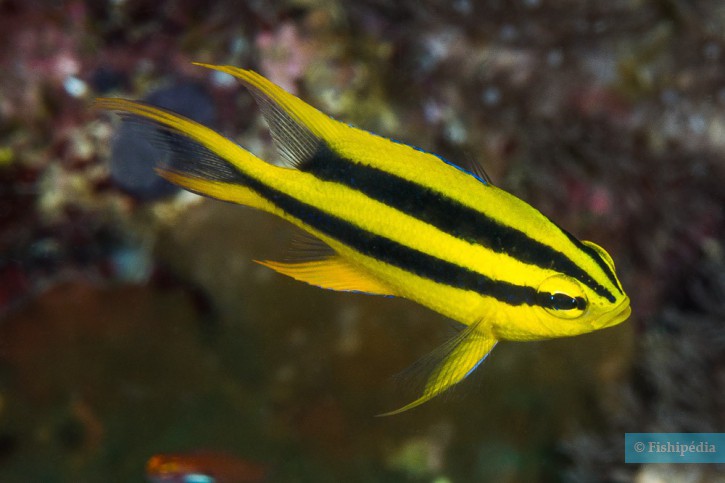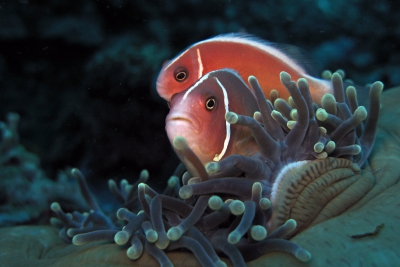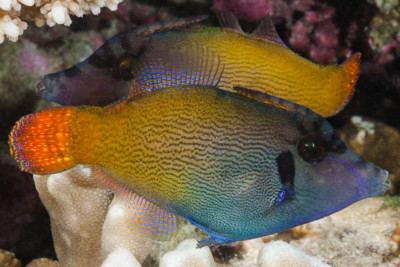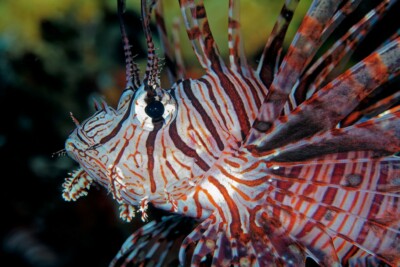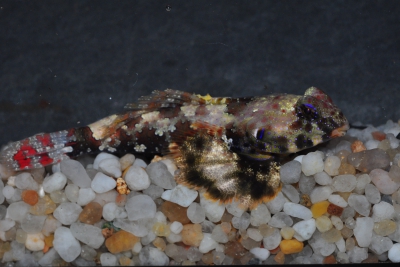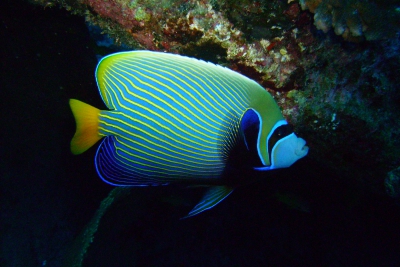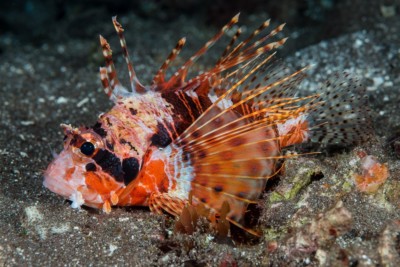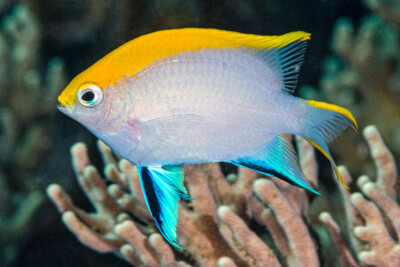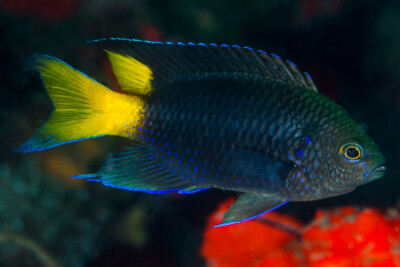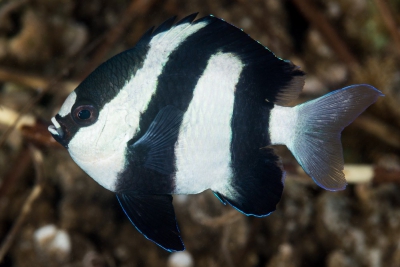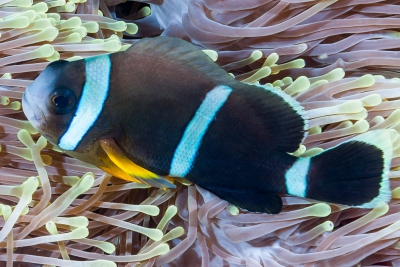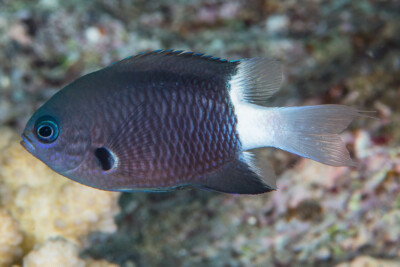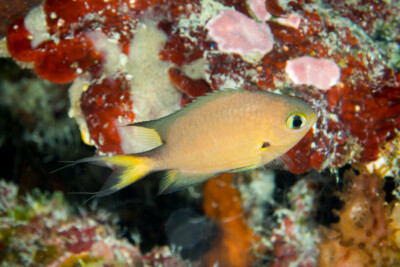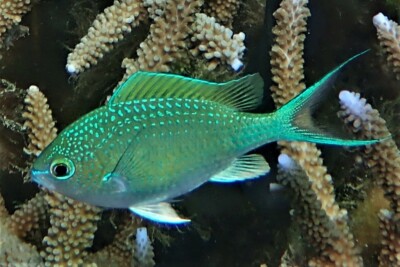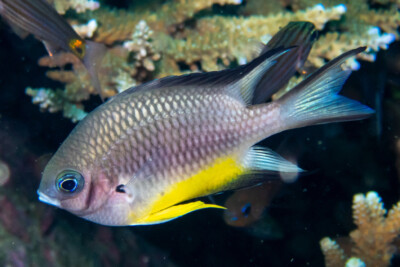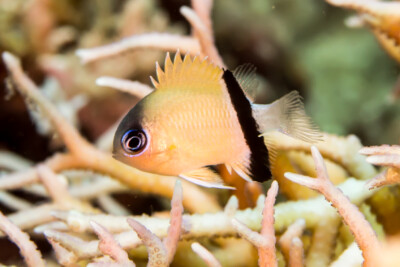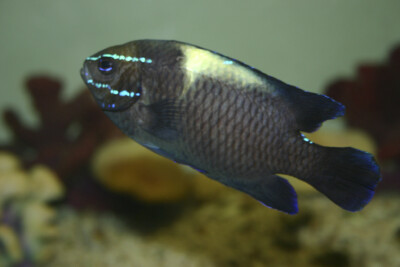black and yellow damsel
| Family | Pomacentridae |
|---|---|
| Genus | Neoglyphidodon |
| IUCN category (World) | LC |
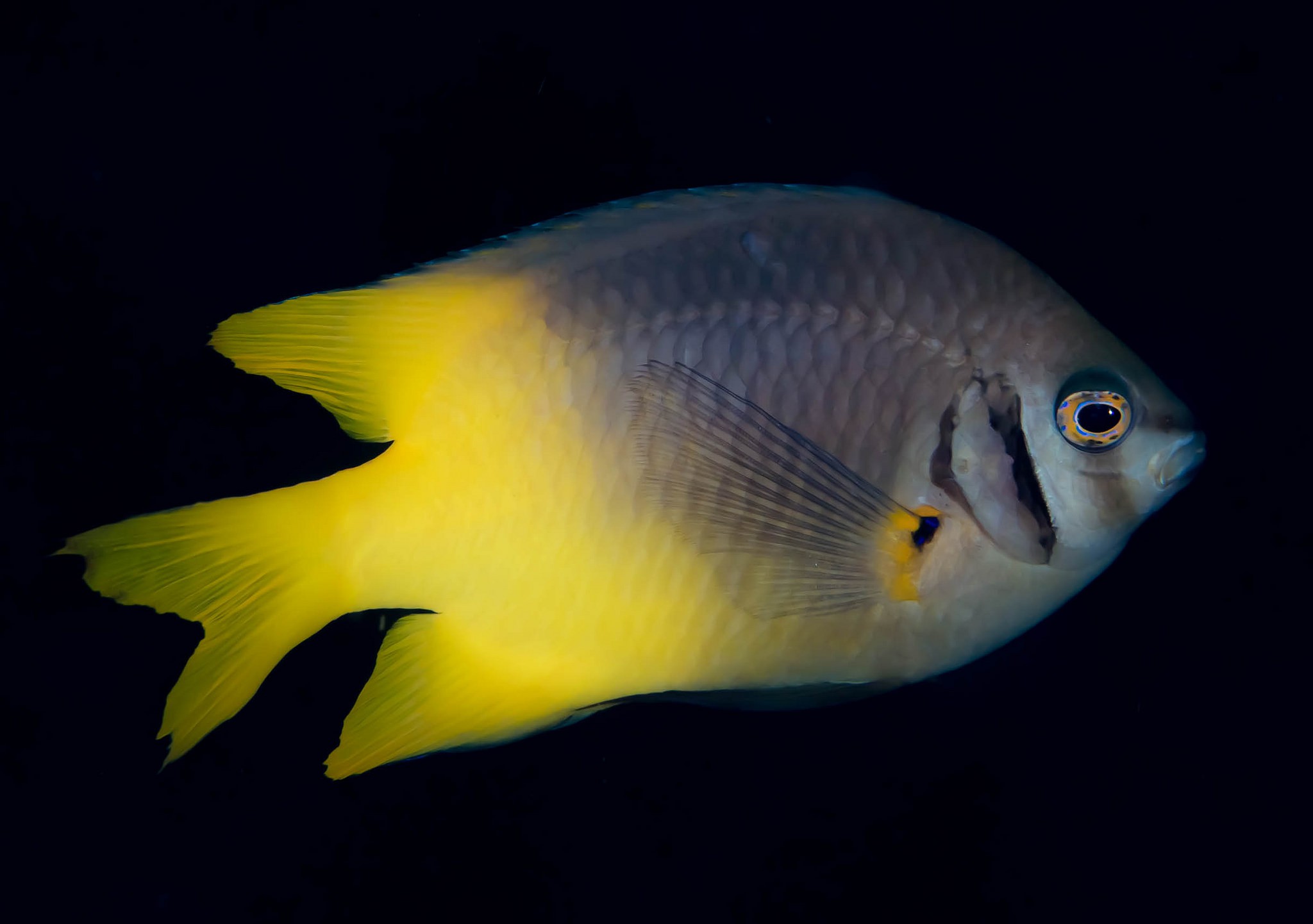

Introduction
Neoglyphidodon nigroris, commonly known as black and yellow damsel, is a salt water fish.
This sheet is currently being prepared. The texts currently proposed come from our data model or are being drafted. To request priority for this content, you can write to us HERE.
Who is it?
Morphology
-
Average size10 cm
-
Maximum size13 cm
-
ShapeOvoid
-
Average size10 cm
-
Maximum size13 cm
-
ShapeOvoid
How to recognize This fish ?
The black and yellow damsel measures between 10 and 13 cm. This fish is bicolore with a predominantly jaune and noir body.
Behaviour & Life cycle
-
dietomnivorous with carnivorous tendency
-
Sociabilityliving as a couple or in a group
-
territorialYes
-
Way of livingdiurnal
The black and yellow damsel is a fish living as a couple or in a group naturally found near the bottom. This species is omnivorous with carnivorous tendency .
The black and yellow damsel is a territorial animal that does not tolerate any incursions into its living area. It is particularly virulent against other territorial species and it can provoke heated fights. Relationships between conspecifics are also hectic, with each seeking to secure its place.
Reproduction
-
Reproductionovipare qui pond sur substrat découvert
-
Hermaphroditeprotandric
The black and yellow damsel is a fish ovipare qui pond sur substrat découvert. This fish always born male. Growing up, individuals will change sex to become female, this is called successive hermaphroditism of the protandrous type.
Harmless species
This species does not represent any particular threats to humans when encountered in its natural environment.
Origin and distribution

What is its habitat?
Natural environment characteristics
-
Temperature22 - 26 °C
-
Depth2 - 23 m
-
FlowMedium
Biotope presentation
The black and yellow damsel is most often found at a depth between 2m and 23m. However, it is not impossible to find this species at other depths.
Species of the same biotope
Main recommendations for fishkeeping
Deontology
In order to preserve wildlife, if you acquire this animal, it must not be released into the wild. See also, the Fishipedia charter.
Fishipedia supports the practice of responsible and environmentally friendly aquarium keeping. We encourage maintenance if it is motivated by a desire to understand the biological functioning of living things and if it is done with respect for animal life.
We believe that aquaristics is an opening to the discovery of aquatic environments, especially freshwater, and that this knowledge is necessary to better protect and respect these environments. Logically, we refute the compulsive purchase of animals that would not find a sufficient and / or adapted place in the host aquarium.
Our recommendations
-
Min volume350 liters
-
Population min2
-
Temperature22 - 26 °C
Characteristics
-
Robustnesstolerant
-
Behaviourmoderately aggressive
-
Availabilityunavailable
General reminders
It is strongly advised to read the complete dedicated file and to get information on the feedbacks of maintenance of the envisaged animal, this to avoid any potential conflict whose end result is generally the death of the individual (or the other inhabitants). It is important not to overload your aquarium to limit pollution. This will make maintenance easier.
General reminder on maintenance datas
Le démarrage d'un aquarium est une partie primordiale pour l'équilibre et le bien-être des poissons. Lorsque l'on met en eau un aquarium, l'eau passe naturellement par un cycle biologique : le cycle de l'azote. Celui-ci dure environ trois semaines. Tous les 2 jours, nous vous conseillons de tester votre eau jusqu'à ce que le taux de nitrite soit à zéro pendant plusieurs jours d'affilée.
Pour accélérer ce cycle, vous pouvez utiliser un activateur de bactéries comme JBL Denitrol. Cette solution riche en bactéries vivantes et enzymes permet une mise en place rapide du cycle de l'azote. Les poissons peuvent alors être introduits plus rapidement.
Il est important de tester l'eau de son aquarium régulièrement pour maintenir un environnement sain pour les poissons et les autres habitants. Les tests d'eau permettent de mesurer les niveaux de différents paramètres tels que le pH, la dureté totale, ainsi que les taux de nitrates, de nitrites et d'ammoniaque.
Pour réaliser ces tests, vous pouvez utiliser des produits d'analyse spécialisés tels que JBL ProScan qui permet de réaliser un diagnostic de l'eau directement via un smartphone. Il existe également des coffrets de tests plus classiques de bandelettes, comme JBL PROAQUATEST.
En cas d’usage de l’eau du robinet, vous pouvez utiliser un conditionneur d’eau de type Biotopol de JBL pour éliminer les substances nocives comme le chlore, le cuivre, le plomb et le zinc. Une eau trop dure ou trop calcaire peut être inadaptée à de nombreuses espèces tropicales d’eau douce. Si nécessaire, vous pouvez la couper avec de l’eau osmosée ou de pluie filtrée afin d’obtenir une dureté plus adaptée aux besoins de vos poissons et de vos plantes. Les conditionneurs d'eau garantissent une meilleure santé aux poissons et une meilleure croissance des plantes.
Chlorine and chloramine are dangerous for the health of animals. Used to disinfect water, these agents are present in significant quantities in tap water. We recommend using an anti-chlorine agent every time you change the water. In addition to chlorine, treatments and medicines sold for aquarium use sometimes contain dangerous heavy metals in high doses.
Specific needs for the black and yellow damsel
The black and yellow damsel is a marine species which lives naturally at a temperature between 22 °C and 26 °C. Nitrate levels should remain below 50mg/L. To keep the water clean and unpolluted, plan on changing 20% to 30% of the water volume each month. In seawater, it is also possible to remove nitrates using one of the following methods: Jaubert, denitrator on sulfur, biopeletts, vodka method.
Cohabitation & Environment
In a community aquarium context, this species should be kept in a minimum volume of 350 liters.
The black and yellow damsel has a strong character. Its maintenance with territorial neighbors in an inadequate volume will generate stress. ndeed, it will not hesitate to fight to protect its territory and to dominate its neighbors. It is important to think carefully about the constitution of the future population to avoid this kind of inconvenience. The aquarium should be arranged so that each species can comfortably define its own territory.
The black and yellow damsel is a fish that generally lives in groups outside of the reproduction periods. If you want to reproduce them and have a good chance of forming a couple, it is recommended to keep at least 5 individuals.. In a community aquarium, the chances of survival of the larvae are almost null. After a few spawns, it is preferable to isolate the couple or to separate from the other members of the group.
The hierarchical organization and the aggressiveness between fellow fish can weaken certain individuals, the presence of hiding places becomes then necessary. If you wish to add new members, it is better to introduce younger fish. They will have a better chance of integrating into the new balance.
Tips for feeding
The black and yellow damsel is omnivorous with carnivorous tendency.
This species can eat dry food (flakes, pellets), fresh food and frozen food. To avoid deficiencies, it is recommended to vary the types of food.
Feed animals in moderation to maintain good water quality. Meals should be eaten within 2–3 minutes, served in several small portions rather than a single large ration.
Uneaten food quickly decomposes, releasing ammonia, nitrites, and nitrates, which disturb the aquarium’s biological balance.
Make sure each species can access food properly, slower or bottom-dwelling individuals may require targeted feeding.Reproduction protocol
-
egg-laying protectionYes
Hybridization risks
In general, it is advised not to mix several species of the same genus or different varieties of the same species, to avoid the risks of hybridization.
These animals might interest you
To go further
Sources & Contributions
Participation & Validation
The Fishipedia team and specialist contributors are committed to providing high-quality content. However, although the information comes from scientific sources or testimonials from specialists, the cards may contain inaccuracies.

Benoit Chartrer

Adrien Falzon
Translation
Translation done with the valuable contribution of our translators, who make this information available to a wider audience. We sincerely thank them for their commitment.
Scientific partners
Tags
Species of the same family
Same genus
Species of the same biotope
